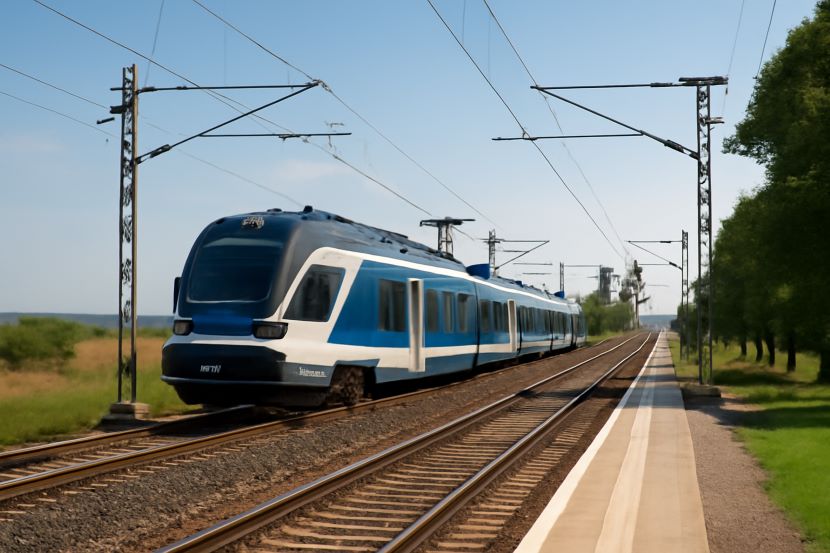Published on
October 10, 2025
Hungary’s Szajol–Debrecen rail line, part of the Budapest–Debrecen route, has just undergone significant upgrades, including the installation of the European Train Control System (ETCS). This advancement will make train travel faster, safer, and more efficient, benefitting not only commuters but also tourists visiting Hungary’s most scenic and historic regions. With these improvements, Hungary’s rail infrastructure is becoming a key player in boosting the tourism sector.
Tourism in Hungary is a key contributor to the economy, and the rail upgrades will allow tourists to easily explore more of the country. The new system allows trains to reach higher speeds, cutting travel times and making destinations like Debrecen much more accessible to visitors. Whether traveling from the capital, Budapest, or from surrounding areas, tourists can now reach this vibrant city with far greater ease.
The Szajol–Debrecen line, covering an impressive 110 kilometers, has always been vital for both domestic and international travelers. Debrecen, Hungary’s second-largest city, is known for its rich cultural scene, including its annual flower carnival and historical landmarks like the Great Reformed Church. For those seeking a more relaxed experience, the city also offers beautiful parks and the nearby Hortobágy National Park, a UNESCO World Heritage site.
Before the rail upgrades, traveling to Debrecen could be cumbersome, especially for international visitors looking to experience the city’s charms. Now, the speed boost from 120 km/h to 160 km/h means tourists can cover the distance much more quickly, offering more time to explore Debrecen’s attractions and neighboring sites. The enhanced connectivity is expected to increase the number of visitors, drawing in tourists who may have otherwise been discouraged by longer travel times.
The addition of ETCS to the line enhances both safety and reliability. For tourists, this means a smoother ride, fewer delays, and ultimately a better overall experience on Hungarian trains. The system will allow the rail network to run more efficiently, with real-time updates and better conflict resolution between trains. This is important for visitors who are often on tight schedules and need reliable transport to make the most of their time in Hungary.
Moreover, the introduction of Level 2 ETCS between Szajol and Ebes has a significant impact on traveler experience. Level 2 utilizes radio signals to transmit movement authority directly to trains, improving accuracy and efficiency. This feature speeds up the journey, ensuring that tourists get to their destinations quicker, without sacrificing safety. Meanwhile, Level 1 technology remains in use between Ebes and Debrecen, providing a seamless balance between modernity and reliability.
The upgrade doesn’t stop at faster travel times. Stations along the Szajol–Debrecen route have also been modernized to improve the passenger experience. Tourists will now find more comfortable waiting areas, clearer signage, and better overall station management. The enhancements make the stations more accessible for people with limited mobility, ensuring that all visitors can travel with ease.
These rail improvements also tie into Hungary’s broader tourism strategy, which aims to make the country a more attractive destination for international visitors. The rail network is one of the most important pieces of Hungary’s tourism infrastructure. It links many popular destinations, including historic cities like Pécs, Szeged, and Eger, with Budapest and each other, offering tourists an easy and convenient way to travel around.
Increased tourist flow to Debrecen is expected to have a positive impact on the local economy. Visitors to the city and the surrounding areas will likely spend more on local goods, services, and attractions. As international tourism continues to recover, the upgrades to the Szajol–Debrecen line will make Hungary a more competitive player in the European tourism market, offering faster connections and more accessibility for visitors from neighboring countries, including Romania and Ukraine.
From a tourism perspective, the modernized rail line also opens up new possibilities for cultural exchange and exploration. Tourists interested in Hungary’s history, nature, and architecture can now visit more sites without the hassle of long travel times. The predictive maintenance features on the line, designed to reduce delays and improve reliability, ensure that tourists can rely on the trains to keep to their schedules, giving them peace of mind as they travel across the country.
The Szajol–Debrecen rail upgrades represent a significant step in Hungary’s ongoing efforts to modernize its infrastructure and make the country a more attractive place for visitors. By improving rail travel efficiency, comfort, and accessibility, Hungary is positioning itself as a premier destination for tourists looking to explore the heart of Europe. This move not only promises to improve tourism but also helps create a sustainable travel environment, where visitors can travel easily while reducing their carbon footprint.
Tourists will find it easier to visit Debrecen, Hortobágy, and many other attractions along the Szajol–Debrecen route. With faster, safer, and more efficient travel options, Hungary is set to enhance the experience for both international visitors and domestic tourists. The rail upgrades are a win for the tourism sector, promising a more enjoyable and stress-free travel experience, allowing tourists to immerse themselves in Hungary’s beauty without the hassle of long journeys.
